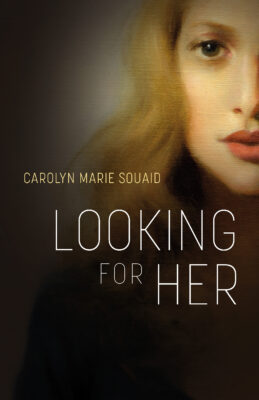Cate Morrissey is a middle-aged English literature professor at McGill. On sabbatical to research and write a paper on settler narratives in Canadian art and poetry, little does she know that a casual conversation in the hospital’s emergency waiting room will lead to life-changing events. Isabel Martinez, bubbly and charming in her own way, is a young paramedic just trying to do what’s right. After discovering what Cate does for a living, Isabel hatches a plan that she is convinced can only bring good.

Looking for Her
Carolyn Marie Souaid
Baraka Books
$24.95
paper
284pp
9781771863483
For such a hefty plan with considerably hefty implications, there is minimal resistance before Cate and her husband, Liam, agree to take in Isabel’s friend, Nuna Maqaittik: a nineteen-year-old Inuk woman from Nunavik living in Montreal with her boyfriend, having left behind a big family and an overcrowded home. On Nuna’s end, despite her interest in getting into college, buying into the idea of being tutored by a complete stranger and living in her Qallunaat home seems contentious. (The Inuktitut term Qallunaat refers to non-Inuit, although more specifically, white people.)
What ensues is an all-too-familiar scenario: a disadvantaged person seems to rise to the occasion by the grace of the upper-middle class. Nuna, a bright, curious, and contemplative soul, takes easily to works by the likes of Dickens and Steinbeck, introduced to her by Cate. Nuna starts calling Cate “Mom” and Liam “Pops” (to his dismay). Between minor instances of familial tension and a one-off late-night drunken incident, Nuna begins reading and writing more, and finds a job at a local bookstore. She even begins to open up to Cate about “her culture and the struggles of her generation, their feelings of discouragement, and hopelessness, the difficulty of living between two worlds, the White world and their own,” but the development of Nuna’s character leaves a lot to be desired. And then one day, Nuna goes missing.
Cate and Isabel’s committed efforts to find Nuna are what define the second half of Souaid’s novel. At the same time, we discover why Isabel is adamant that Cate is Nuna’s only way out. As the daughter of a hardworking single mother from Mexico, it turns out that it’s all thanks to a wealthy Westmount family (her mother’s employer) that Isabel was saved from the perils of the working class. She is blind to her own internalized oppression. As days pass, with still no news of Nuna, it becomes clearer that the fervent pursuit of the young Inuk woman’s whereabouts is, in fact, more about Cate’s search for herself.
Cate is pulled out of her mundane white, heteronormative existence and into an adventure, in which she not only benefits from the “fresh life” Nuna has breathed into her research, but gets to play detective after Nuna’s disappearance. As Isabel’s presence grows stronger in Cate’s everyday life, Cate also has the chance to explore the initial attraction she feels towards Isabel. The cherry on top is finding reason to discover a part of the world unknown to most below the 55th parallel – in hopes of tracking Nuna down, Cate travels all the way to Nunavik.
As a daughter of hardworking immigrants myself, who has personal ties to Mexico, and who has worked with the Inuit of Nunavik over the last few years, I can appreciate the constructive conversation that Souaid’s work puts forward. Although it’s never fully understood where Nuna is and what has become of her, at least in the end, we are given the satisfaction of knowing that Cate (and Isabel, to some extent) finally makes a breakthrough in recognizing how her “good” intentions to educate Nuna were, in fact, misguided. Challenging as it was to come to terms with my personal plight vis-à-vis various elements in the book, Looking for Her is a novel worth unpacking and talking about.mRb






0 Comments